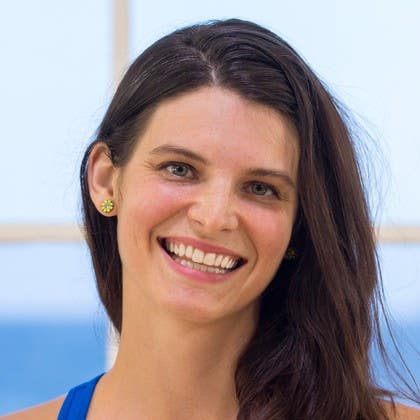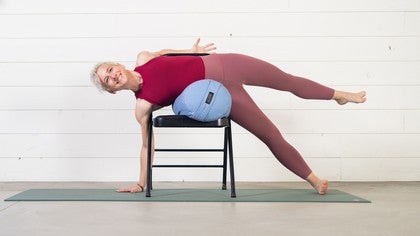
The Less Yoga I Do, The More Like a Yogi I Feel
In 2016, while waiting on the train in New York City’s Union Square after a yoga class, a line popped into my mind like a long-forgotten song: “You can’t hide from yourself in stretch pants forever.”
The class I’d just taken was packed. Like a golden retriever puppy, I smiled at everyone, did a few pre-class warm-ups, as if the other students saw how great my practice was, they might invite me for juice after class. (I know, I know.) The class was a ‘heart opener,’ chock full of intense back bending and handstands. Back pain limited my heart opening, and I’ve never been great at handstands. I spent most of the class in Low Cobras and Child’s Pose and left feeling lonely, and pathetic for feeling lonely.
That line about hiding from your life in stretch pants? It shocked me when I heard it. I was 27, living in Shanghai, and asana-obsessed. I had found my calling as a teacher and was devoted to my practice. A teacher of mine said it, almost in passing, when I asked what she was working on her own practice. "I don’t do much asana", she said, laughing. "Turns out, you can’t hide from yourself in stretch pants forever." She gifted me Ravi Ravindra’s The Wisdom of Patanjali’s Yoga Sutras, which I read a few chapters of and set aside for later. Like, I was trying to nail the transition from Handstand to Scorpion, and she wanted to talk about Self with a capital S? I couldn’t imagine saying I didn’t do asana practice, and I hardly had any clothes that weren’t stretch pants.
Cue the identity crisis
For years, my approach to the other yoga limbs was similar to drinking water when I would wake up with a hangover - chug a giant glass and wait for it to kick in. I read the texts, engaged with the ideas, but the postural practice resonated most deeply with me. Embodiment meant using my body. Physical yoga, and specifically Ashtanga, gave me confidence and comfort. I knew the rhythms, the cues, the cadences.
But by the time I took that class in New York City, I needed change. For one thing, I was in pain. An injury I’d ignored for years was suddenly screaming at me, my lower back seared after every Upward Facing Dog. And I was also confused. For over a decade, yoga was my life. Everyone knew me as a yogi; life was a small town in one of the world’s biggest cities. But I was tired. I was ready for yoga to be something I did, not something I was. Postural practice was supposed to lead toward enlightenment, but I just felt lost.
Hiding in my stretch pants
There’s nothing like an injury to keep you humble, but New York City is a strange place to try and lose your ego. The first year, the city felt like the boyfriend that breaks up with you by saying, "It’s not me, it’s you." In classes, students regularly out-practiced me, taking each posture to its extreme. Yoga felt like a competition I was losing. Back pain prevented me from keeping up, anyway, and not being able to perform my yoga was embarrassingly challenging. I felt insecure and lonely, and the place where I had previously found security and community - yoga practice - was changing, too. I missed my old friends, my old body, my old self.
In yogic terms, the ego is often referred to as the story of the self. When something happens that we like (raga), we give it our attention, we want to return to it. When something happens that we don’t like (dvesa), we try to avert it. In his book The Inner Tradition of Yoga, Michael Stone refers to this dynamic as a constant push-pull that gives us the feeling of a real self. Waiting on the train, feeling silly and sore, I realized I needed to change my story.
In the West, we most often experience the Eight Limbs of Yoga as a ladder and climb up and down throughout practice. Asana is usually the first limb most students encounter and explore. Following Asana, the third limb on Patanjali’s 8-limbed path, they work backward toward the Yamas and Niyamas, respectively. Pranayama, or breath control, is number four and is often blended in with Asana or numbers 5 and 6, Pratyahara (withdrawing of the senses), and Dharana (concentration). Dhyana, the uninterrupted flow of all previous meditation stages, comes just before Samadhi, absorption of all and, presumably, total bliss.
As I thought about what my teacher said about hiding from her life in her stretch pants, I also considered my relationship to the other parts of yoga, like ahimsa, the concept of non-injury explained in the Yamas. I was in pain, but more than that, my life had changed, and with it, my sense of self. Not acknowledging that was also painful. The insecurity, the injury, and my ego, it was all a part of the story I’d been giving attention to, the feeling of self.
Redefining asana
It was around this time I started doing less yoga and running more. My approach was similar to how I did yoga: I ran on the same track, in the same lane, at the same time each day, for the same amount of miles. At first, I was clumsy; my feet felt like bricks, my breath raked through my ribs. I worried that I wouldn’t be liked if I didn’t do yoga, as if yoga was a personality trait. I worried my body would never recover enough to do my regular practice, I worried I’d never find another calling. I remembered a line I loved from the Bhagavad Gita: "A true yogi is one who finds light and delight with themselves." Each loop brought me closer to something familiar: Asana.
Although it almost always means physical practice in the West, Asana has a much more complex definition. Some scholars translate it from Sanskrit as a seat, as in taking a seat for meditation. One particular verse, sthira sukham asanam, can be translated as "Asana is what is steady and pleasant".
Running and yoga are similar practices in that their barriers to entry are low. You need a body that is alive, nothing else. After a few months, I left the track and ran along the water, the skyline over my shoulder, following the briny smell of the river. As the landscape shifted with each block, I recognized more of my new city and more of myself. Steady and pleasant.
All is coming and all is here
I wanted yoga to just be something I did, but that’s not what yoga is. Yoga and the Eight Limbs are a branching, growing thing that lives and stretches and breathes. As yoga teacher Susanna Barkataki wrote recently, “Yoga is not something you do; it is something you are. We come alive when we realize every moment is an opportunity to practice yoga.” I didn’t really understand this until I left my yoga practice, and returned to it in a new way. The physical practice orients the mind toward something - the Self with a capital S. In Ashtanga, it’s said, “practice and all is coming.” And all is coming, but all is here. Here is self, here is yoga. Yoga gives me the tools to move through the muck and beauty of being in a body that is alive.
Finding our unique Yoga
When I was obsessed with asana, I thought I knew everything. I knew where to put my shoulder in Bakasana, how to use my baby toe for balance. But I didn’t know how to integrate my whole self into my practice. I still don’t, but it’s okay. My asana practice looks and feels different these days. I modify almost all the poses in the Primary Series, I wiggle, wobble, and sit in stretches of attempted quiet. Most days, it doesn’t look like much. But it's mine.
The less yoga I do, the more I realize I don’t know, and the more like a yogi I feel. Ravi Ravindra (yes, I did eventually read it!) describes yoga as one way, one of many, and through practice and study, we proceed from the many to one. On that path, we find our unique yoga. A handstand does not a yogi make, nor does reading ancient texts alone make you wise. The integration of what makes us unique - our insecurities, our fears, our egos, our selves, and our feelings of self - is what makes us yogis.
I still have more stretch pants than I do pairs of jeans. The city still sometimes feels like a bad romance, my back still hurts sometimes, the classes can still be showy. But now I laugh - "You’re right," I think. "It’s not you, it’s me."
Comments
You need to be a subscriber to post a comment.
Please Log In or Create an Account to start your free trial.











